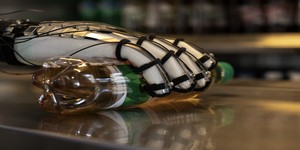
Fujitsu has released details of a glove-based controller which it hopes to bring to market before the end of its next financial year as the perfect accessory for the growing number of wearable computers being launched.
Currently existing in prototype form at the company's Fujitsu Laboratories division in Kawasaki, Japan, the controller is worn like a somewhat odd-looking glove. A ring-like attachment on the finger contains a near-field communication (NFC) reader and contact-detection sensor, while the body of the glove itself includes a gyroscopic sensor and accelerometer.
'Smartphones, tablets, and other smart devices have made work more efficient by digitising the process of activity-logging, and attempts have been made to use them to support work outside of office environments,' the company explained of its creation. 'But in some work settings, such as those that require gloves to be worn or environments in which hands get dirty, taking out and using a conventional smart device can be difficult. Another hurdle is that users need to stop what they are doing in order to use their smart device.'
Initially, Fujitsu imagines the device being used in industrial environments: objects can be tagged using NFC stickers, and then marked by the reader located on the user's finger. Gesture-based control could be used to report issues with an item, or to acknowledge a work=-related order. The company claims its relatively bare-bones system can recognise six patterns - up, down, left, right, rotate left and rotate right - with 98 per cent accuracy, using the relatively unnatural dorsiflex position of the arm to distinguish between normal arm movements and those directed at the glove's recognition system.
Previous attempts at glove-based controllers have not been a massive success. Perhaps the most famous was the PAX Power Glove for the Nintendo Family Computer, launched in the US and Europe as the Mattel Power Glove for the NES: based on a cost-reduced version of technology built for industrial use in the VPL Dataglove, the glove used flex-sensors in each digit apart from the little finger and an ultrasonic tracking system to control games - but its accuracy left a lot to be desired. More recently, the Peregrine attempted to replace the keyboard with a chording-style control system, but lacks the positional tracking and natural control of its predecessor.
Fujitsu has indicated that it hopes to bring the glove controller to market by the end of its 2015 financial year, although initial models are likely to be high-priced versions aimed at industrial use.
Currently existing in prototype form at the company's Fujitsu Laboratories division in Kawasaki, Japan, the controller is worn like a somewhat odd-looking glove. A ring-like attachment on the finger contains a near-field communication (NFC) reader and contact-detection sensor, while the body of the glove itself includes a gyroscopic sensor and accelerometer.
'Smartphones, tablets, and other smart devices have made work more efficient by digitising the process of activity-logging, and attempts have been made to use them to support work outside of office environments,' the company explained of its creation. 'But in some work settings, such as those that require gloves to be worn or environments in which hands get dirty, taking out and using a conventional smart device can be difficult. Another hurdle is that users need to stop what they are doing in order to use their smart device.'
Initially, Fujitsu imagines the device being used in industrial environments: objects can be tagged using NFC stickers, and then marked by the reader located on the user's finger. Gesture-based control could be used to report issues with an item, or to acknowledge a work=-related order. The company claims its relatively bare-bones system can recognise six patterns - up, down, left, right, rotate left and rotate right - with 98 per cent accuracy, using the relatively unnatural dorsiflex position of the arm to distinguish between normal arm movements and those directed at the glove's recognition system.
Previous attempts at glove-based controllers have not been a massive success. Perhaps the most famous was the PAX Power Glove for the Nintendo Family Computer, launched in the US and Europe as the Mattel Power Glove for the NES: based on a cost-reduced version of technology built for industrial use in the VPL Dataglove, the glove used flex-sensors in each digit apart from the little finger and an ultrasonic tracking system to control games - but its accuracy left a lot to be desired. More recently, the Peregrine attempted to replace the keyboard with a chording-style control system, but lacks the positional tracking and natural control of its predecessor.
Fujitsu has indicated that it hopes to bring the glove controller to market by the end of its 2015 financial year, although initial models are likely to be high-priced versions aimed at industrial use.

MSI MPG Velox 100R Chassis Review
October 14 2021 | 15:04








Want to comment? Please log in.